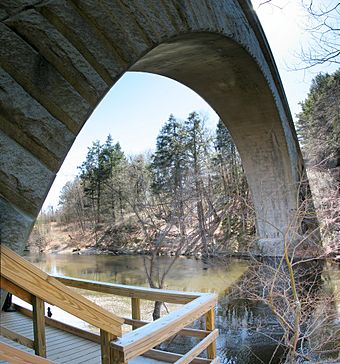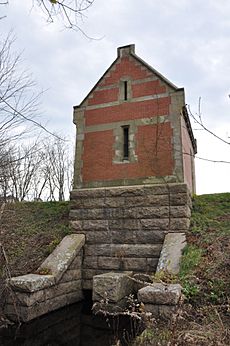Sudbury Aqueduct facts for kids
Quick facts for kids |
|
|
Sudbury Aqueduct Linear District
|
|

North side of Echo Bridge which carries Sudbury Aqueduct over the Charles River between Needham and Newton
|
|
| Lua error in Module:Location_map at line 420: attempt to index field 'wikibase' (a nil value). | |
| Location | Framingham, Sherborn, Natick, Wellesley, Needham, and Newton, Massachusetts, United States |
|---|---|
| Built | 1878 |
| Architect | George A. Clough |
| MPS | Water Supply System of Metropolitan Boston MPS |
| NRHP reference No. | 89002293 |
| Added to NRHP | January 18, 1990 |
The Sudbury Aqueduct is a long water channel in Massachusetts. It was built to carry water to the city of Boston and nearby towns. This important structure stretches about 16 miles (26 km). It starts at Farm Pond in Framingham. Then it goes all the way to Chestnut Hill Reservoir in Boston's Chestnut Hill area.
The aqueduct passes through several towns. These include Sherborn, Natick, Wellesley, and Needham. It crosses the Charles River on a famous bridge called Echo Bridge. The aqueduct ends at the Chestnut Hill Reservoir. Today, the Massachusetts Water Resources Authority (MWRA) takes care of the aqueduct.
Building the Aqueduct
The Sudbury Aqueduct was built between 1875 and 1878. It was used to carry water for almost 100 years. Its main job was to bring water from the Sudbury River area to Boston. To hold this water, several reservoirs were built. These included reservoirs in Framingham and Southborough. Later, more reservoirs were added in Ashland and Hopkinton. This was done to meet the growing need for water.
In 1898, the Sudbury Reservoir was created. This greatly increased the amount of water available. For most of its history, the aqueduct got its water mainly from the Foss Reservoir. The Sudbury Reservoir fed water into the Foss Reservoir. Other reservoirs were kept as backup supplies.
How it was built
The aqueduct is mostly made of brick. It has a special horseshoe shape. It is about 8.5 feet (2.6 meters) wide and 7.6 feet (2.3 meters) high. The bricks are held together with concrete. They sit on a strong base of concrete and stone. A brick arch covers the top of the aqueduct.
The aqueduct was designed to carry a lot of water. It could move 80 million gallons of water each day. Later, its capacity was increased to 110 million gallons per day. The main channel slopes down one foot for every mile. This helps the water flow.
Along the aqueduct, small buildings were constructed. These buildings held equipment to control the water flow. For example, there was a gate house at Farm Pond. There were also control houses over weirs. Weirs are structures that help control water levels. These control points allowed water to be sent to other areas if needed.
There are also control houses at the Rosemary Brook siphon in Wellesley. A siphon is like a giant pipe that helps water cross a low area. Here, water goes through cast iron pipes. This part of the aqueduct shows different building methods. Some parts are raised on an embankment (a raised bank of earth). Other parts are in a cut (a channel dug into the ground). This was needed because the land changed a lot.
In some places, like Natick and Newton, tunnels were dug. The longest tunnel in Newton is about 4,635 feet (1,413 meters) long. Besides the Echo Bridge, the aqueduct also crosses the "Waban Arches" bridge. This bridge has nine arches. It carries the aqueduct over a valley in Wellesley. The aqueduct officially ends at a building near the Chestnut Hill Reservoir in Newton.
Used as a Backup System
Over time, newer aqueducts were built. These included the Weston Aqueduct, the Hultman Aqueduct, and the MetroWest Water Supply Tunnel. These new systems took over the job of carrying water. The Sudbury Aqueduct stopped being used for daily service in 1978.
Now, the Sudbury Aqueduct is part of the MWRA's emergency backup system. If there's a problem with the main water pipes, the Sudbury Aqueduct can be used. It can carry water from the Sudbury and Foss reservoirs. These are important backup water sources. If activated, water would flow from the Foss Reservoir into the Sudbury Aqueduct. Then it would go to Chestnut Hill Reservoir. From there, it could enter the main water system.

The aqueduct was used in an emergency on May 1, 2010. A large water pipe broke in Weston. To keep water flowing, the MWRA used the Chestnut Hill Reservoir. Water from the Sudbury and Foss Reservoirs was sent through the Sudbury Aqueduct to keep the Chestnut Hill supply full. Because this water was not treated, about 2 million people had to boil their tap water for a few days. Later tests showed the water was safe to drink.
On January 18, 1990, the Sudbury Aqueduct was recognized as a historic place. It was added to the National Register of Historic Places. Many parts of the aqueduct's path are now open to the public. People can walk along it as a trail.

